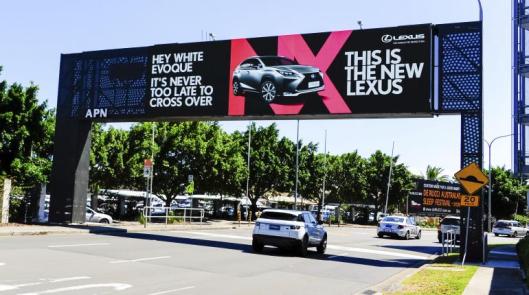Arens et al (2009) describes outdoor advertising, or out-of-home media, as a broad category of media which reaches prospects outside their homes, such as through bus and taxicab advertising, subway posters, billboards, and so on. There are many media and creative considerations for developing outdoor advertising in order to increase its effectiveness.
In terms of creative execution, Arens et al (2009), Lamar (2014), Adstruc (2012), The Hangline (2011) and Suggett (n.d.) all mutually agree that the recommended maximum for outdoor copy is seven words, as outdoor ads are often fleeting messages. Arens et al (2009), Lamar (2014) and The Hangline (2011) also indicate that simple typefaces should be used as opposed to ornate, overly bold and overly thin typefaces to increase legibility, and spacing between letters and words should be increased to increase readability. Contrasting colours should also be implemented in order to reduce the ‘blurring’ effect.
In terms of media considerations for effective outdoor advertising, The Hangline (2011) and Suggett (n.d.) both advise that outdoor advertising, particularly media like billboards, is not always the place for a call to action or direct response. The Hangline (2011) also indicates that every ad should have a clear and directed target audience. Finally, all sources emphasise the significance of being creative in execution in order for the ad to resonate with the audience.

In January 2015, M&C Saatchi in collaboration with APN Outdoor and TMS developed a campaign around using smart billboards for Lexus (APN Outdoor, 2015).
The billboard pictured above was one of the 5 billboards positioned in high traffic areas within Australia’s major cities. The billboard used a specially designed system with cameras to recognise the make, model and colour of cars that drove under the billboard, and displayed personalised messages to other luxury car drivers on the road encouraging them to trade up to a Lexus NX Crossover (APN Outdoor, 2015).
In many aspects, Lexus’ digital billboard as pictured above aligns with the industry established guidelines for developing effective outdoor ads. The colour contrast of the predominantly black and white ad is effective and in line with industry guidelines; there is no direct call for action in terms of phone numbers or websites; there is a clear target audience, as the ad only displays personal messages to drivers in luxury vehicles (Karras, 2015); and finally, many advertising practitioners have reviewed this as an innovative and uniquely targeted digital billboard. MDG Advertising (2015) states that “while people expect personalized messages while on the Web or in promotional emails, the use of this targeting on outdoor ads elevates the technology to a brand new level.” Micallef (2015) quotes Adrian Weimers, Lexus Australia Corporate Manager, Sales and Operations, as saying that “being able to target the competitor and have a bit of fun with it is brilliant.” Campaign Brief (2015) and Aquilina (2015) both indicate that this billboard is simply an excellently executed innovative ad, and the first of it’s kind within Australia.
However, while the ad is cleverly targeted, innovative and effectively positioned in strategic high traffic areas of major Australian cities, one major misalignment with established industry guidelines is that the amount of words within the ad exceeds 7, and the spacing between lines of text are possibly too close together for words in capital letters. The readability of the ad could be perceived as low, and it’s possible drivers may not be able to read the entire ad within the given exposure time due to the amount of words.
In essence, Lexus’ digital billboard is almost a prime example of effective outdoor advertising, and further considerations and alignments with industry guidelines would have increased the ad’s effectiveness.
References:
Adstruc. (2012). How To Create An Effective Outdoor Ad. Retrieved April 24, 2015, from Adstruc: http://news.adstruc.com/post/19963413500/how-to-create-an-effective-outdoor-ad
APN Outdoor. (2015, January 20). Australia’s smartest billboards talk to motorists for Lexus via M&C Saatchi, APN Outdoor and TMS. Retrieved April 24, 2015, from APN Outdoor: http://www.apnoutdoor.com.au/about-us/our-news/20-01-2015/australia-s-smartest-billboards-talk-to-motorists-for-lexus-via-m-c-saatchi-apn-outdoor-and-tms
Aquilina, S. (2015, January 20). Lexus interactive billboards: ‘direct messaging on steroids’. Retrieved April 24, 2015, from Marketing Mag: https://www.marketingmag.com.au/news-c/lexus-interactive-billboards-direct-messaging-steroids/
Arens, W. F., Schaefer, D. H. & Weigold, M. (2009). Essentials of Contemporary Advertising (2nd ed.). New York, USA: McGraw-Hill Irwin.
Campaign Brief. (2015, January 19). Australia’s smartest billboards talk to motorists for Lexus via M&C Saatchi, APN Outdoor + TMS. Retrieved April 24, 2015, from Campaign Brief: http://www.campaignbrief.com/2015/01/australias-smartest-billboards.html
Karras, J. (2015, March 4). LEXUS Billboard OOH Casestudy [Video File]. Retrieved April 24, 2015, from Youtube: https://www.youtube.com/watch?v=7TgTHJ66ubk#t=13
Lamar. (2014). Design Tips. Retrieved April 24, 2015, from Lamar Advertising: http://www.lamar.com/HowToAdvertise/DesignTips
MDG Advertising. (2015, April 11). Lexus Outdoor Advertising Goes High-Tech Down Under. Retrieved April 24, 2015, from MDG Advertising: http://www.mdgadvertising.com/blog/lexus-outdoor-advertising-goes-high-tech-down-under/
Micallef, R. (2015, January 18). Smart outdoor gets smarter: Lexus targets competitor cars. Retrieved April 24, 2015, from AdNews: http://www.adnews.com.au/news/smart-outdoor-gets-smarter-lexus-targets-competitor-cars
Suggett, P. (n.d.). The Six Basic Rules of Billboard Advertising. Retrieved April 24, 2015, from About – Advertising: http://advertising.about.com/od/advertisingglossaryb/a/The-Six-Basic-Rules-Of-Billboard-Advertising.htm
The Hangline. (2011, January 24). The 10 Commandments of Outdoor Advertising. Retrieved April 24, 2015, from The Hangline: http://www.thehangline.com/articles/the-10-commandments-of-outdoor-advertising/
